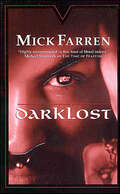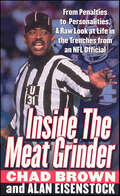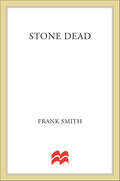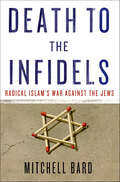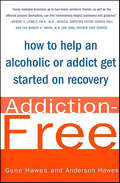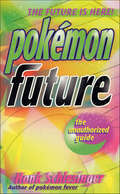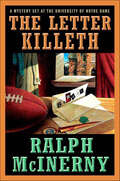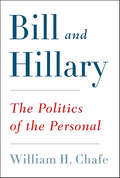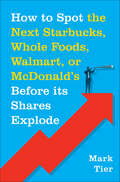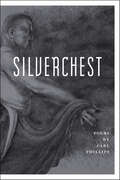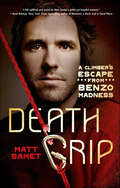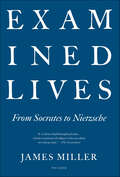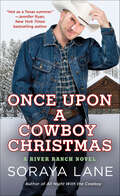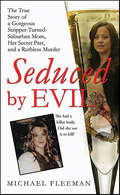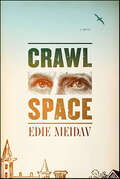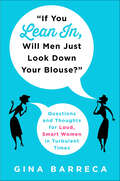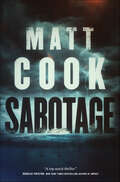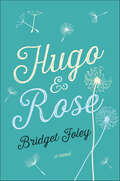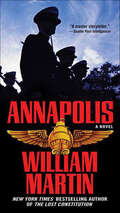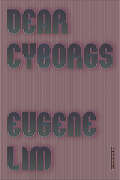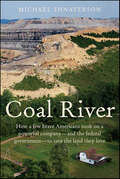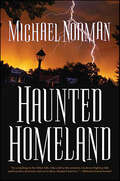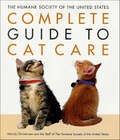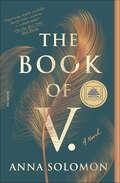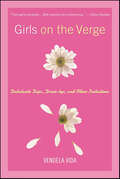- Table View
- List View
Darklost (Renquist Quartet)
by Mick FarrenLos Angeles--City of Angels, city of dreams. But sometimes the dreams become nightmares.Having fled New York, Victor Renquist and his small group of Nosferatu are striving to reestablish their Colony in Los Angeles. They have become a deeper, darker part of the city's nightlife. And Hollywood's glitterati are hot on the scent of a new thrill, one that outshines all others--immortality.But someone, somewhere, is meddling with even darker powers, powers that even the Nosferatu fear. Someone is attempting to summon the entity of ancient evil known at Cthulhu.And Renquist must overcome dissent in his own Colony, solve the riddle of the Darklost (a being brought partway along the Nosferatu path and then abandoned), and combat powerful enemies to save the world--of humans!At the Publisher's request, this title is being sold without Digital Rights Management Software (DRM) applied.
Inside The Meat Grinder
by Alan Eisenstock Chad BrownThis electrifying book, Inside the Meat Grinder, exposes the hard-hitting reality of life in the trenches for an NFL referee.Welcome to the violent world of former NFL referee Chad Brown, where three-hundred-pound men hurtle at each other at supercharged speeds. Where intimidation is a way of life. And where Chad is the man marked in stripes, the man in the middle, the man who throws the yellow flag-or doesn't.This insider's account covers a wide-range of topics, including:* On-Field Action: what players and coaches are really saying on the field in the heat of battle. * Dirty Tricks: how NFL players have perfected the art of escaping penalties-or getting them called on an opponent. * Ballistic Coaches: what it's like to have everyone--coaches, players, and a whole stadium full of fans--trying to intimidate you every moment of the game.* Instant Replay: why the video tape can make an official look like a fool or a genius-and why sometimes the tape lies.Packed with action and inside stories on some of the game's greatest players-and biggest whiners-Inside the Meat Grinder is a hard-hitting look at hardcore NFL action, where Chad Brown, a boy hell-raiser turned football player turned NFL zebra, plays the toughest position on the field.
Stone Dead (The Neil Paget Mysteries)
by Frank SmithStone Dead is Frank Smith's second novel featuring British Chief Inspector Neil Paget. A routine robbery investigation turns into something much more sinister when a corpse is found in the well of a cottage belonging to photographer Peter Foster. Foster fears the body is the ex-husband of his current girlfriend, a model shooting on location in France. Worse, he fears Lisa may have killed him.But Lisa herself has mysteriously disappeared, and the true identity of the corpse adds a strange twist to the already-convoluted crime. A murder has taken place--but who is the victim, and who is the killer? It seems everyone involved knows something, but not enough to piece together an emerging puzzle of love and hate--until a fatal mistake leads Paget to the shocking solution . . . in Frank Smith's Stone Dead.
Death to the Infidels: Radical Islam's War Against the Jews
by Mitchell BardFor more than a century, much of the attention given to the Middle East has focused on the Arab-Israeli conflict. The rise of a Palestinian offshoot of Egypt's Muslim Brotherhood, the Islamic Resistance Movement, or Hamas, transformed the nature of the conflict between Israel and the Palestinians. According to Bard, the dispute, in the view of Hamas, is not over a division of Palestine, but rather about Jews ruling over Muslims and the presence of Jews on Islamic land. However, this Islamic-Jewish conflict is not simply confined to the Middle East. Muslim terrorist attacks have been directed at Jews all around the world, from Europe to Asia to Latin America. Radical Muslims in European countries are becoming more brazen, particularly in France, where the Muslims constitute nearly ten percent of the population. In just the last year, there have been several Muslim attacks on Jews throughout France. Death to the Infidels documents the growth of radical Islam in the Middle East and how, from the author's interpretation, it has transformed what had primarily been a political conflict into a one-sided religious war limiting the prospect for peace, particularly in Israel.
Addiction-Free: How to Help an Alcoholic or Addict Get Started on Recovery
by Gene Hawes Anderson HawesA thorough guide about how to get help for a friend or loved one who is having problems with alcohol or other drugs. Provides places, names, numbers--who to call, what questions to ask, and what to expect. This invaluable guide includes six initial options for getting into recovery:-- The AA treatment program--Interventions, detox and rehab--Work related programs--Al-Anon--Law-enforcement programs--Therapeutic communitiesAddiction-Free: How to Help an Alcoholic or Addict Get Started on Recovery is a much-needed guide for everyone whose life is touched by addiction.
Pokémon Future: The Unauthorized Guide
by Hank SchlesingerAre you a Poké-maniac?If so, you'll need to read on about all the cool new developments in the world of Pokémon! Learn from today's finest Pokémon masters—kids just like you—how to win at the new versions of this awesome game of monsters, and discover all the exciting new Pokémon products and off-shoots.
The Letter Killeth: A Mystery Set at the University of Notre Dame (Roger and Philip Knight Mysteries)
by Ralph McInernyOnce the college football season draws to a close for the Fighting Irish, there is little reason to ride out the winter in South Bend, Indiana. Those who can leave do, but P.I. Philip Knight stays on at Notre Dame when the university asks him to discreetly investigate a rash of threatening letters that have been sent to a number of administrators, including the new football coach, who resurrected the team in a single year.While conspiracy theories are as prevalent as the cold, Philip and his brother Roger think the letters are probably a prank or possibly a student paper's attempt at yellow journalism but nothing more. Then a controversial professor's car is set on fire, a man is found dead on campus, and the Knight brothers find themselves hot on the trail of a killer in Ralph McInerny's tenth mystery set at Notre Dame.
Bill and Hillary: The Politics of the Personal
by William H. ChafeIn Bill and Hillary: The Politics of the Personal, the distinguished historian William H. Chafe boldly argues that the trajectory of the Clintons' political lives can be understood only through the prism of their personal relationship. Each experienced a difficult childhood. Bill had an abusive stepfather, and his mother was in denial about the family's pathology. He believed that his success as a public servant would redeem the family. Hillary grew up with an autocratic father and a self-sacrificing mother whose most important lesson for her daughter was the necessity of family togetherness. As an adolescent, Hillary's encounter with her youth minister helped set her moral compass on issues of race and social justice.From the day they first met at Yale Law School, Bill and Hillary were inseparable, even though their relationship was inherently volatile. The personal dynamic between them would go on to determine their political fates. Hillary was instrumental in Bill's triumphs as Arkansas's governor and saved his presidential candidacy in 1992 by standing with him during the Gennifer Flowers sex scandal. He responded by delegating to her powers that no other First Lady had ever exercised. Always tempestuous, their relationship had as many lows as it did highs, from near divorce to stunning electoral and political successes.Chafe's many insights—into subjects such as health care, Kenneth Starr, welfare reform, and the extent to which the Lewinsky scandal finally freed Hillary to become a politician in her own right and return to the consensus reformer she had been in college and law school—add texture and depth to our understanding of the Clintons' experience together. The latest book from one of our preeminent historians, Bill and Hillary is the definitive account of the Clintons' relationship and its far-reaching impact on American political life.
How to Spot the Next Starbucks, Whole Foods, Walmart, or McDonald's Before its Shares Explode
by Mark TierEveryone knows the basic golden rule of investing: “Buy Low, Sell High,” but how many of us ever really understand the stock market, how to recognize the “next big thing,” and how to capitalize off of it once you do? ...the truth is not many or we’d all be millionaires. It seems like early investors in big companies like Facebook and Google had to have won the lottery of investing and just gotten really lucky, but there’s more to it than that. There’s a science to the “Next Big Thing” strategy, and Mark Tier understands it. In How to Spot the Next Starbucks, Whole Foods, Walmart, or McDonald's BEFORE Its Shares Explode, Tier shows readers that explosive brands like Starbucks, Whole Foods, McDonald's, and Walmart didn’t become successful on accident. Through in-depth and accessible case studies, Tier pulls back the curtain on the early Key Performance Indicators that each of these major companies showed even at their earliest stages. Once you learn how to recognize these makings of success, you too will be able to spot the next Starbucks.
Silverchest: Poems
by Carl Phillips"After / the afterlife, there's an afterlife."In Silverchest, his twelfth book, Carl Phillips considers how our fears and excesses, the damage we cause both to others and to ourselves, intentional and not, can lead not only to a kind of wisdom but also to renewal, maybe even joy, if we're willing to commit fully to a life in which "I love you / means what, exactly?" In poems shot through with his signature mix of eros, restless energy, and moral scrutiny, Phillips argues for the particular courage it takes to look at the self squarely—not with judgment but with understanding—and extend that self more honestly toward others. It's a risk, there's a lot to lose, but if it's true that "we'll drown anyway—why not / in color?"
Death Grip: A Climber's Escape from Benzo Madness
by Matt SametDeath Grip chronicles a top climber's near-fatal struggle with anxiety and depression, and his nightmarish journey through the dangerous world of prescription drugs. Matt Samet lived to climb, and craved the challenge, risk, and exhilaration of conquering sheer rock faces around the United States and internationally. But Samet's depression, compounded by the extreme diet and fitness practices of climbers, led him to seek professional help. He entered the murky, inescapable world of psychiatric medicine, where he developed a dangerous addiction to prescribed medications—primarily "benzos," or benzodiazepines—that landed him in institutions and nearly killed him.With dramatic storytelling, persuasive research data, and searing honesty, Matt Samet reveals the hidden epidemic of benzo addiction, which some have suggested can be harder to quit than heroin. Millions of adults and teenagers are prescribed these drugs, but few understand how addictive they are—and how dangerous long-term usage can be, even when prescribed by doctors.After a difficult struggle with addiction, Samet slowly makes his way to a life in recovery through perseverance and a deep love of rock climbing. Conveying both the exhilaration of climbing in the wilderness and the utter madness of addiction, Death Grip is a powerful and revelatory memoir.
Examined Lives: From Socrates to Nietzsche
by James MillerA New York Times Notable Book for 2011 We all want to know how to live. But before the good life was reduced to ten easy steps or a prescription from the doctor, philosophers offered arresting answers to the most fundamental questions about who we are and what makes for a life worth living.In Examined Lives, James Miller returns to this vibrant tradition with short, lively biographies of twelve famous philosophers. Socrates spent his life examining himself and the assumptions of others. His most famous student, Plato, risked his reputation to tutor a tyrant. Diogenes carried a bright lamp in broad daylight and announced he was "looking for a man." Aristotle's alliance with Alexander the Great presaged Seneca's complex role in the court of the Roman Emperor Nero. Augustine discovered God within himself. Montaigne and Descartes struggled to explore their deepest convictions in eras of murderous religious warfare. Rousseau aspired to a life of perfect virtue. Kant elaborated a new ideal of autonomy. Emerson successfully preached a gospel of self-reliance for the new American nation. And Nietzsche tried "to compose into one and bring together what is fragment and riddle and dreadful chance in man," before he lapsed into catatonic madness. With a flair for paradox and rich anecdote, Examined Lives is a book that confirms the continuing relevance of philosophy today—and explores the most urgent questions about what it means to live a good life.
Once Upon a Cowboy Christmas: A River Ranch Novel (A River Ranch Novel #3)
by Soraya LaneBillionaires, cowboys, and romance collide during the holidays in this next book in the River Ranch series! It’s the most wonderful time of the year at the Ford family ranch. Will one cowboy’s homecoming be the greatest gift of all?He left town and never looked back.Cody Ford is a Wall Street honcho with humble Texas roots. This holiday season, he’d be content to just stay in New York and not face his family—and dodge their questions about when and with whom he plans to settle down. . .and if he will do so back at home. But his father isn’t getting any younger, and Cody doesn’t want to miss any last chances to see him and the rest of the folks back on the ranch. The last person Cody was expecting to see? His one-time girlfriend, Lexi Murphy, who’s been working as his dad’s new live-in nurse.She never forgot him. Can she ever forgive him?Lexi still holds a grudge against Cody. Back then, the college-bound heartthrob believed he was too good for a small-town girl like Lexi. But now Cody can’t help but see her in a whole new light. Could it be that this beautiful single mother with an unbeatable can-do spirit is the one he’s been waiting for all along? That depends on whether Cody can prove to Lexi that, this time, he means business—and if a sudden snowstorm can lend just the right amount of Christmas magic to help move things along. . .“Lane warms hearts of readers across the globe.”—RT Book Reviews
Seduced by Evil: The True Story of a Gorgeous Stripper-Turned-Suburban-Mom, Her Secret Past, and a Ruthless Murder
by Michael FleemanAs an exotic dancer at The Great Alaskan Bush Company in Anchorage, Mechele Hughes Linehan knew how to captivate men. Three of them were convinced she was engaged to them. Then one spring morning in 1996, one man, Kent Leppink, was found in the snow, shot in the head…Days before his death, Kent had removed Mechele's name from his million-dollar life insurance policy. He wrote a letter to his family stating that, should he meet foul play, Mechele would likely be among those involved. But she wasn't charged with Kent's death. She married a doctor, moved to Olympia, Washington, and began a new life. For years, Mechele's suburban friends never suspected a thing. She went to school meetings, hosted backyard barbeques, and was beloved by her neighbors. But authorities eventually found enough evidence to mount a case against her and an alleged accomplice. Did Mechele conspire to kill her ex-fiancé? Or is she the innocent victim as she claims? Seduced by Evil is the shocking true story about a love triangle that ended in mystery—and murder…
Crawl Space: A Novel
by Edie MeidavA war criminal returns to the scene of the crimeIt's 1999 and Emile Poulquet awaits sentencing in a Paris court for deporting thousands to almost certain death during World War II. But haunted by ghosts from his past, and determined to confront his dark legacy, he escapes and heads toward his beloved Finier, a rural town in the south of France where he once served as prefect. His return will have explosive consequences.In Finier, Poulquet finds shelter within the strange embrace of a group of teenage wastrels, and encounters new breeds of idealism, degeneracy, and friendship. He sets out to find Arianne-a lifelong obsession and the widow of a Resistance hero-in order to hand her his last will and testament. But as he begins his quest, he cannot help being drawn, inexorably, toward another circle of refugees and reporters in town for a wartime reunion. He doesn't yet know that his worst betrayal-and the greatest test of his own ability to pardon another-is yet to come. By turns epic and intimate, reflective and slyly humorous, Crawl Space limns the gray zone between past and future. Edie Meidav poignantly describes one man's tragic attempt to come to terms with the past.
If You Lean In, Will Men Just Look Down Your Blouse?: Questions and Thoughts for Loud, Smart Women in Turbulent Times
by Gina BarrecaGina Barreca is fed up with women who lean in, but don't open their mouths. In her latest collection of essays, she turns her attention to subjects like bondage which she notes now seems to come in fifty shades of grey and has been renamed Spanx. She muses on those lessons learned in Kindergarten that every woman must unlearn like not having to hold the hand of the person you're waking next to (especially if he's a bad boyfriend) or needing to have milk, cookies and a nap every day at 3:00 PM (which tends to sap one's energy not to mention what it does to one's waistline). She sounds off about all those things a woman hates to hear from a man like "Calm down" or "Next time, try buying shoes that fit". "'If You Lean In, Will Men Just Look Down Your Blouse?'" is about getting loud, getting love, getting ahead and getting the first draw (or the last shot). Here are tips, lessons and bold confessions about bad boyfriends at any age, about friends we love and ones we can't stand anymore, about waist size and wasted time, about panic, placebos, placentas and certain kinds of not-so adorable paternalism attached to certain kinds of politicians. The world is kept lively by loud women talking and "'If You Lean In, Will Men Just Look Down Your Blouse?'" cheers and challenges those voices to come together and speak up. You think she's kidding? Oh, boy, do you have another thing coming.
Sabotage
by Matt CookA cruise ship loses power in the North Atlantic. A satellite launches in the South Pacific. Professor Malcolm Clare—celebrated aviator, entrepreneur, and aerospace engineer—disappears from Stanford University and wakes up aboard an unknown jet, minutes before the aircraft plunges into the high seas. An extortionist code-named "Viking" has seized control of a private warfare technology, pitting a U.S. defense corporation against terrorist conspirators in a bidding war. His leverage: a threat to destroy the luxury liner and its 3,000 passengers. Stanford doctoral student Austin Hardy, probing the disappearance of his professor, seeks out Malcolm Clare's daughter Victoria, an icy brunette with a secret that sweeps them to Saint Petersburg. Helped by a team of graduates on campus, they must devise Trojan horses, outfox an assassin, escape murder in Bruges, and sidestep treachery in order to unravel Viking's scheme. Failure would ensure economic armageddon in the United States.Both on U.S. soil and thousands of miles away, the story roars into action at supersonic speed. Filled with an enigmatic cast of characters, Sabotage, Matt Cook's debut novel, is a sure thrill ride for those who love the puzzles of technology, cryptology, and people. At the Publisher's request, this title is being sold without Digital Rights Management Software (DRM) applied.
Hugo & Rose: A Novel
by Bridget FoleyRose is disappointed with her life, though she has no reason to be - she has a beautiful family and a perfectly nice house in the suburbs. But to Rose, this ordinary life feels overshadowed by her other life - the one she leads every night in her dreams.After a childhood accident, Rose's dreams take her to a wondrous island fraught with adventure. On this island, she has never been alone: she shares it with Hugo, a brave boy who's grown up with her into a hero of a man. But when Rose stumbles across Hugo in real life, both her real and dream worlds are changed forever. Here is the man who has shared all of her incredible adventures in impossible places, who grew up with her, even if they aren't what either one imagined. Their chance encounter begins a cascade of questions, lies, and a dangerous obsession that threatens to topple everything she knows. Is she willing to let go of everything she holds dear to understand their extraordinary connection? And will it lead her to discover who she truly wants to be?
Annapolis: A Novel
by William MartinFrom the days of pirate raids on the Chesapeake to swift-boat actions in Vietnam, the Staffords and their traditional rivals, the Parrishes, struggle with foreign enemies and each other to build a navy and a nation. They march across the deserts of Tripoli, sail into the South Seas to battle the British and dally with the native girls, fight aboard the Merrimac and the Monitor, fly into the battle of Midway, and look into the living faces of all four men on Mount Rushmore. When Stafford descendant Susan Browne sets out to film a documentary about her famous ancestry, her work sweeps her into the past, to celebrate Stafford victories, mourn their losses, and confront their secrets. Annapolis is William Martin's most ambitious novel, a tale of romance and courage, honor and patriotism, an ode to the men and women who have made the proud traditions of the United States Navy.At the Publisher's request, this title is being sold without Digital Rights Management Software (DRM) applied.
Dear Cyborgs: A Novel
by Eugene LimOne of Vol. 1 Brooklyn's Favorite Fiction Books of 2017, a Literary Hub Staff Favorite Book of 2017, and one of BOMB Magazine's "Looking Back on 2017: Literature" Selections."Wondrous . . . [A] sense of the erratic and tangential quality of everyday life—even if it’s displaced into a bizarre, parallel world—drifts off the page, into the world you see, after reading Dear Cyborgs." —Hua Hsu, The New YorkerIn a small Midwestern town, two Asian American boys bond over their outcast status and a mutual love of comic books. Meanwhile, in an alternative or perhaps future universe, a team of superheroes ponder modern society during their time off. Between black-ops missions and rescuing hostages, they swap stories of artistic malaise and muse on the seemingly inescapable grip of market economics. Gleefully toying with the conventions of the novel, Dear Cyborgs weaves together the story of a friendship’s dissolution with a provocative and timely meditation on protest. Through a series of linked monologues, a lively cast of characters explores narratives of resistance—protest art, eco-terrorists, Occupy squatters, pyromaniacal militants—and the extent to which any of these can truly withstand and influence the cold demands of contemporary capitalism. All the while, a mysterious cybernetic book of clairvoyance beckons, and trusted allies start to disappear.Entwining comic-book villains with cultural critiques, Eugene Lim’s Dear Cyborgs is a fleet-footed literary exploration of power, friendship, and creativity. Ambitious and knowing, it combines detective pulps, subversive philosophy, and Hollywood chase scenes, unfolding like the composites and revelations of a dream.
Coal River: How a Few Brave Americans Took On a Powerful Company —and the Federal Government—to Save the Land They Love
by Michael ShnayersonOne of America's most dramatic environmental battles is unfolding in southern West Virginia. Coal companies are blasting the mountains, decapitating them for coal. The forested ridge tops and valley streams of Appalachia—one of the country's natural treasures—are being destroyed, along with towns and communities. An entire culture is disappearing, and to this day, most Americans have no idea it's happening.Michael Shnayerson first traveled to the coal fields four years ago, on assignment for Vanity Fair. There he met an inspiring young lawyer named Joe Lovett, who was fighting mountaintop removal in court with a series of brilliant and daring lawsuits. He also met Judy Bonds, whose grassroots group, the Coal River Mountain Watch, was speaking out in a region where talking truth to power was both brave and dangerous. The two had joined forces to take on Massey Energy, the largest and most aggressive of the coal companies, and its swaggering, notorious chairman, Don Blankenship.Coal River is Shnayerson's account of this dramatic struggle. From courtroom to boardroom, forest clearing to factory floor, Shnayerson gives us a novelistic and compelling portrait of the people who risked their reputations and livelihoods in the fight against King Coal.
Haunted Homeland (Haunted America)
by Michael NormanTrapped miners from cave-ins long ago still calling for help.Ghostly women lurking in the shadows of city streets.Spectral holy men and outlaws from America's Spanish past making appearances in our modern age. They are all citizens of Haunted America, and this is HAUNTED HOMELAND.From a haunted castle in the wilds of Alaska to phantom clergymen in the Southwest and mysterious bouncing lights on the East Coast, this latest volume covers the places, the people, and the things that belong to the earthbound realm of the fantastic. Michael Norman has gathered together spectral events of all kinds--apparitions of the famous like Mary Surratt, Mary Todd Lincoln, and Mad Anthony Wayne; haunted crime scenes in Chicago and along the Indiana byways; as well as banshees, poltergeists, and even a ghost named George who has become an accepted resident in a house in North Carolina.Some of these tales date back to America's early days, such as the screaming woman of Marblehead, Massachusetts, while others rise from more contemporary sources, like noted mystery writer Mary Robert Rhinehart's encounter with ghost at a house on Long Island.A ghostly Supreme Court Justice, a specter known as The Texan, an abandoned Canadian bride reminiscent of Dickens's Miss Haversham, and many others make an appearance in this latest chronicle of the Haunted American landscape.At the Publisher's request, this title is being sold without Digital Rights Management Software (DRM) applied.
The Humane Society of the United States Complete Guide to Cat Care
by Wendy Christensen The Staff of The Humane Society of the United StatesBuilding a lifelong, loving relationship with a cat can be a challenging task. Whether you're thinking of adopting a cat or already live with one, The Humane Society of the United States Complete Guide to Cat Care offers authoritative and practical advice that will help you make the best decisions for your pet along the way. This comprehensive guide includes sections on choosing a healthy cat or kitten, feeding and nutrition, training, grooming, disease, vet visits, caring for an aging cat, feline first-aid kits and emergency care.Unlike other books that endorse breeding and promote novelty or purebred cats, The Humane Society's Guide to Cat Care stresses making life better for the millions of cats already here. It provides information on rescuing and rehabilitating homeless cats, finding a stray's owner, and helping an outdoor cat make the transition to a safe indoor environment. The guide also encourages animal advocacy and offers a list of ways to get involved.
The Book of V.: A Novel
by Anna SolomonA GOOD MORNING AMERICA BOOK CLUB PICKA BELLETRIST BOOK CLUB PICKFor fans of The Hours and Fates and Furies, a bold, kaleidoscopic novel intertwining the lives of three women across three centuries as their stories of sex, power, and desire finally converge in the present day.Lily is a mother and a daughter. And a second wife. And a writer, maybe? Or she was going to be, before she had children. Now, in her rented Brooklyn apartment she’s grappling with her sexual and intellectual desires, while also trying to manage her roles as a mother and a wife in 2016. Vivian Barr seems to be the perfect political wife, dedicated to helping her charismatic and ambitious husband find success in Watergate-era Washington D.C. But one night he demands a humiliating favor, and her refusal to obey changes the course of her life—along with the lives of others.Esther is a fiercely independent young woman in ancient Persia, where she and her uncle’s tribe live a tenuous existence outside the palace walls. When an innocent mistake results in devastating consequences for her people, she is offered up as a sacrifice to please the King, in the hopes that she will save them all. In Anna Solomon's The Book of V., these three characters' riveting stories overlap and ultimately collide, illuminating how women’s lives have and have not changed over thousands of years.
Girls on the Verge: Debutante Dips, Drive-bys, and Other Initiations
by Vendela VidaIn a fascinating look at how young women are coming of age in America, Vendela Vida's Girls on the Verge explores a variety of rituals that girls have adapted or created in order to leave their childhoods behind. Vida doesn't just observe the rituals, she actively participates in them, going as far as spending a week at UCLA to experience rush--she emerges a Tri-Delt. She also goes to Miami to learn about the "quince" (the Latin American celebration of a girl's fifteenth birthday), to Houston to take part in a debutante ball, to Los Angeles and San Francisco to talk to female gang members, to Salem, Massachusetts, to interview a coven of witches, and to Las Vegas to watch young brides take the plunge--some of them in drive-through wedding chapels. With humor, insight, and illuminating detail, she explores girls' struggles to forge an identity and secure a sense of belonging through various rituals--rituals that they embrace without necessarily understanding the comforts they seek or the repercussions of their often all-too-adult choices.
